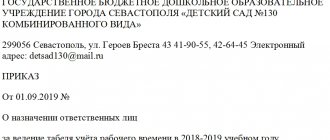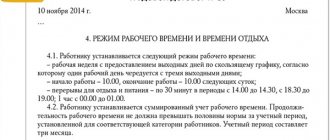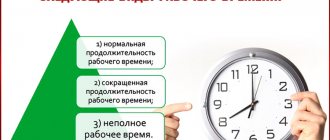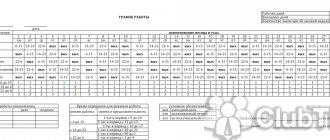Last modified: February 2021
Sometimes enterprises establish a special regime that differs from the generally accepted 40 hours a week. The administration of the enterprise is faced with the problem of implementing legislation on acceptable workload during the day or week, which creates a need for proper load regulation and accounting for workload in another way. The provision on summarized recording of working time allows us to resolve the issue of determining the workload, breaks and rest of employees when the usual norms of a 40-hour week are not applicable due to the specifics of the organization.
General concept
Working time tracking is monitoring the activities of employees in accordance with the established work schedule in a particular organization. It is necessary to maintain labor discipline, since otherwise employees may abuse the trust of the employer.
Recording of working time must be clearly consistent with the provisions of the Labor Code, according to which every employee has the right to breaks during the day, legal weekends and vacations.
Article 91 of the Labor Code of the Russian Federation talks about what should be considered working time. The internal labor regulations in each organization should not conflict with this article.
Working time tracking is necessary in order to :
control the attendance of employees at the appointed time and detect those who are late and absent;- check the presence of workers on site throughout the entire period of working time, their return from lunch break without delay;
- compliance with the end of the working day;
- registration of paid working time, divided into actual hours worked, forced downtime, annual and sick leave, as well as other types of paid working time.
Position
The regulatory act on the distribution of working time of employees in each individual organization is called the regulation on working time recording.
Everything stated in this provision should not conflict with the Labor Code of the Russian Federation and current legislation. This document consists of separate paragraphs describing each of the possible violations of labor regulations.
From among the employees of the departments in each organization, persons responsible for maintaining the time sheet .
The responsibilities of these persons include:
draw up work schedules;- note the time of arrival and departure of employees, their compliance with the time they are at work in accordance with the regulations;
- bring information about absences, absenteeism and tardiness to the attention of the department head;
- check documents justifying the right of employees to be absent from the workplace (sick leave, dismissal, etc.)
Employees who are responsible for keeping timesheets must be familiar with the provisions on recording working hours against signature.
Employer's liability
For violation of procedures for recording working hours worked at an enterprise, the administration will bear administrative liability in the form of fines in the following amounts:
- up to 5 thousand rubles per specific manager for violation of general labor standards, including the procedure for recording working hours;
- up to 5 thousand rubles (for a manager), or with a work stoppage of up to 90 days, if violations of labor standards are simultaneously associated with the lack of legal registration of the employer;
- up to 50 thousand rubles, or work stoppage for up to 90 days, if a legal entity is found responsible for violating labor standards.
Form for receiving a question, write yours
Peculiarities
During the work process, situations may arise that require a special approach to the distribution of employee working time :
- Weekends and holidays . According to the Labor Code of the Russian Federation, work on weekends and holidays is prohibited. However, labor regulations within an organization may provide for employees to go to work under special conditions (double pay, time off).
. Entered into the timesheet as a separate column.
Overtime work- Forced absenteeism is the absence of an employee from the workplace due to the fault of the employer. After all the circumstances have been clarified, missed work time is paid as if the employee was present and participated in the work process.
- Downtime . They can arise for various reasons, including the fault of the employee. In this case, the employee does not receive any payment for the downtime, and if the downtime was not his fault, he receives full payment for the missed time.
- Incapacity due to illness . In this case, the employee is paid partially.
- The day the business trip ends . On this day, the employee is not required to go to work, but receives travel money.
Overtime work and requirements for its documentation
According to Article 99 of the Labor Code, overtime is considered to be work outside the normal working hours. Overtime work in cumulative accounting of working hours is defined as work in excess of the established number of working hours during the accounting period.
The law allows overtime work in several situations:
- if there is a threat of property damage, harm to human life or health;
- if it is necessary to restore mechanisms, the non-working state of which will lead to downtime for large groups of workers;
- if it is necessary to continue work if the replacement does not show up in cases where the work process cannot be interrupted and the employer must take immediate measures to replace the employee.
A mandatory requirement when engaging an employee to work overtime is to obtain his written consent. Without written consent, overtime work is permitted only to eliminate the consequences of disasters.
Overtime work must be reflected in time sheets. In a remuneration system where hours worked outside working hours are taken into account in the motivational part, the time must be recorded in timesheets.
Kinds
There are three main types of working time tracking: daily, weekly and cumulative.
Daily accounting
A type of working time tracking in which the duration of the work shift is always the same. This is the most common schedule - 40 working hours per week and always the same 8-hour working day - the so-called “five-day week”.
If an employee is forced to stay late at the workplace or appear there on weekends to complete all tasks, then this is counted as overtime work .
Monday
With this type of accounting, the length of the working week is always the same (usually 40 hours), but the length of the working day can vary significantly.
In this case, the total number of working hours per week should always be the same.
Shift and flexible work schedules correlate with weekly accounting .
Summarized
Some types of work require such an organization of the work process that it is impossible to distribute time into equal work shifts or weeks.
For example, with shift work, flexible hours, seasonal work, continuous production or 24-hour work, there may be a need for aggregated time recording.
This method involves creating an accounting period lasting more than one week (for example, a month, a quarter or a half-year, maximum a year).
The duration of the accounting period for more than 1 year is not allowed under the Labor Code of the Russian Federation (Part 1 of Article 104) .
If you determine the actual time worked in terms of a week, then the average value should not go beyond the established norm.
Types of accounting
There are two types of accounting for the use of labor time: continuous and variance method. The continuous method is also called the day method. The deviation method is also called weekly accounting. Both types are used to optimize work in an organization, depending on its specifics.
Day accounting is used in organizations with the same length of shifts. The use of this type of timesheet helps to record the hours worked by the employee and avoid overtime by individual employees.
In addition, this method makes it possible to take into account the rights and interests of employees of the preferential group, for whom individual working hours are established, in accordance with Article 94 of the Labor Code of the Russian Federation (minors under 16 and under 18 years of age, disabled people, athletes, teachers, and so on).
Weekly accounting applies to employees with a flexible schedule, for whom different durations of work each day based on the results of the week constitute the norm. This method is used for special specifics of the organization’s work or by agreement with the employee.
Methods
There are several methods for recording working hours that are necessary to improve labor discipline:
- Control of the time of arrival to work and departure home by a responsible person , for example, a watchman, who records this time in a special journal and submits reports to management.
- Control of the work process by a specially appointed employee . He usually spends his working hours in the same room with other employees who are supervised. This method ensures a more rational use of working time and minimizes unauthorized absences of employees from the work process.
. With this method of control, employees themselves record and submit information about the use of their working time to management in the form of reports. Such reports reflect the amount of work done per unit of time and motivate employees to be diligent.
Reporting from the employees themselves- Controlled access to workplaces . Such control can be carried out using special cards or even by scanning fingerprints. Each employee’s exit and entry into the office is recorded in a special file and automatically transferred to management.
- CCTV . Perhaps the most reliable of all methods of recording working time, but also the most expensive. In addition to installing security cameras, you also need a separate employee who constantly monitors everything that happens in the organization and records violations of the work schedule. In addition, this method causes many employees a feeling of psychological discomfort, therefore it is used very limitedly and mainly where it is necessary (warehouses, bases, self-service stores).
- Special software that records all employee actions during the day. Applies mainly to those who work in the office and at the computer.
Time sheet
A human resources specialist or other authorized employee enters data on colleagues’ hours worked and unworked into the primary accounting form - a time sheet. Traditionally, unified form No. T-12 “Sheet for recording working time and calculating wages” or form No. T-13 “Sheet for recording working time” (Resolution of the State Statistics Committee of the Russian Federation No. 1) are used. An organization can develop and approve its own form of time sheet, but in this case the document must contain all the necessary details provided for in Part 2 of Art. 9 of Law No. 402-FZ.
The Kontur-Personnel program automatically maintains a timesheet in accordance with the selected schedule and taking into account all deviations issued by orders for vacations, sick leave, absences, overtime, etc.
To learn more
To fill out the report card, Goskomstat has provided a system of symbols. But you have the right to develop your own. Moreover, the list proposed by the department does not take into account all possible employment options for employees. For example, there are no symbols to reflect work at night on a shift or on weekends on a business trip.
Filling out the timesheet can be organized in different ways:
- registration of deviations (no-shows, overtime hours worked, delays, etc.);
- continuous recording of all appearances and absences.
For companies with a small number of employees and standard working hours, it is convenient to record only deviations. If the enterprise has a large number of employees with different work schedules, it is advisable to use continuous registration.
Report card
A document containing data on how much time each employee actually worked, how many times he missed work and for what reason is called a time sheet.
On its basis, employees' wages are calculated. Depending on the method of recording working hours, the timesheet can be filled out either manually or automatically .
For processing and calculation of wages, this document is transferred to the accounting department.
Rules
The main rule regarding the recording of working time is the mandatory generation of time sheets on paper. This is done even if the timesheet is initially filled out automatically by electronic devices.
The timesheet must be kept in accordance with the form, on special forms. The time sheet is opened on the first day of each month.
The timesheet is transferred to the accounting department of the enterprise before each cash payment to employees, for example, before issuing an advance and calculating:
- Each employee must have an individual personnel number;
- At the end of the month, the results for each employee are summed up and the actual time worked is calculated.
Order
Keeping records of working hours is determined by law. The absence of such records in an institution is a direct violation of the rights of workers.
It is also mandatory to establish an operating mode:
length of the working day or shift;- agreement to work irregular hours;
- approval of the start and end times of work;
- breaks from work for rest.
When drawing up time sheets and exercising control over the work process, the employer must be guided not only by the Labor Code and his own convenience, but also select the optimal time frame and tracking methods for employees, since this will directly affect the quality of work of each individual employee, and in the end at the enterprise as a whole.
Control methods
Any time tracking system will be successfully used if the employer chooses the right control methods. The choice of control method depends on the specifics of the organization’s activities, the discipline of employees, corporate ethics, the financial position of the organization and the ratio of income and costs.
There are two main time tracking systems - manual and automated.
Any time tracking system will work successfully if the employer chooses the right control methods. The choice of control system depends on the specifics of the enterprise, the discipline of employees, corporate ethics, the financial position of the organization and the ratio of income and costs.
The most used methods of recording working hours are the following: access control (turnstiles, log), attendance control by immediate supervisors, assigning responsibilities to the workers themselves (compiling a report on the work done during the day), the use of video cameras and special software. Automated methods are assigned to IT department employees.







